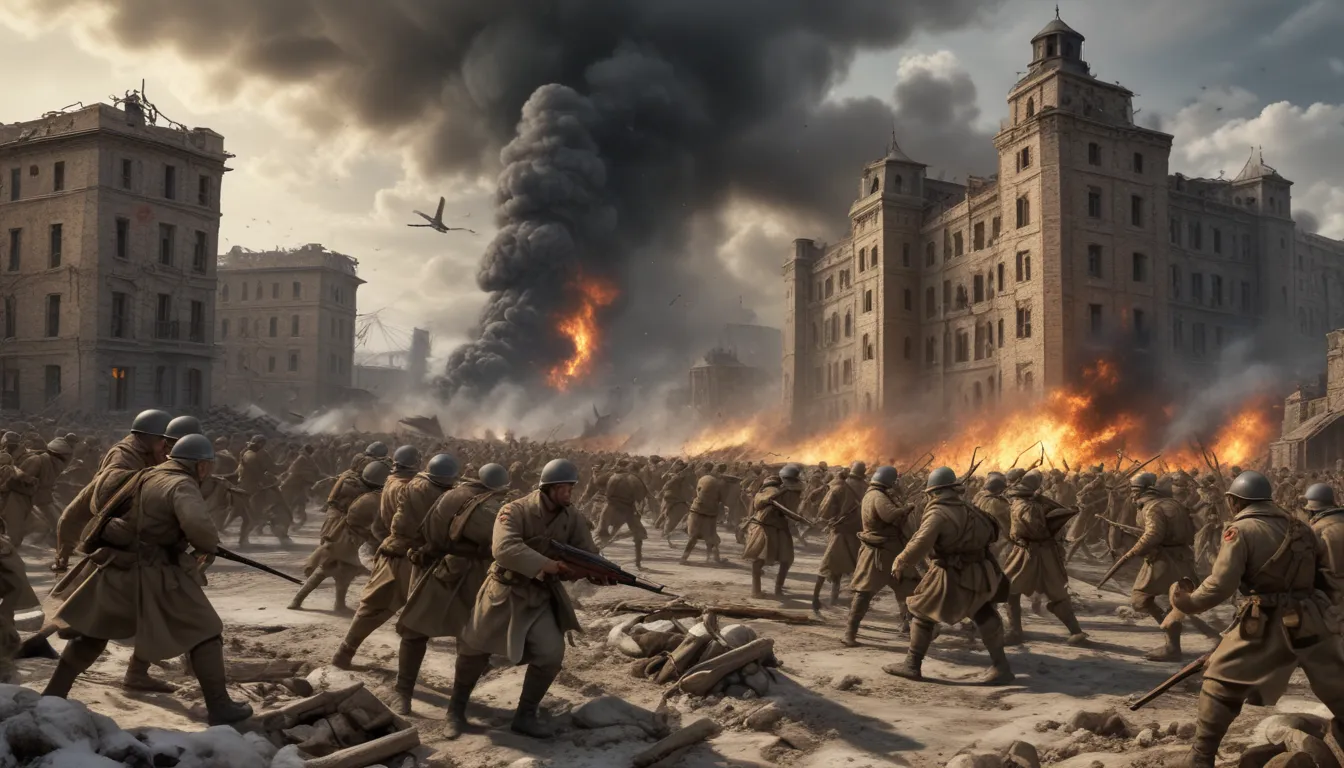The images in our articles may not match the content exactly. They are used to grab your attention, not to show the exact details in the text. The images complement the text but do not replace it.
Welcome to the gripping tale of one of the most pivotal battles in history – the Battle of Stalingrad. This monumental clash between the Soviet Union and the Axis powers during World War II was not just a mere military confrontation; it was a test of endurance, bravery, and the indomitable human spirit. Join us as we unravel the astonishing facts surrounding this epic showdown that reshaped the course of the war and left a lasting impact on the world.
The Turning Point of World War II
The Battle of Stalingrad, spanning from July 17, 1942, to February 2, 1943, stands out as a watershed moment in World War II. It symbolized the turning of the tide against the Axis powers and showcased the unwavering determination of the Soviet Union to defend its homeland. Here are some intriguing facts about this historic battle:
- Stalingrad was strategically significant as a key industrial city and a gateway to the Caucasus oil fields, vital for the Nazi war effort.
- The battle was named after the city itself, Stalingrad, which was later renamed Volgograd in 1961, marking a pivotal moment in history.
The Scale of the Conflict
The Battle of Stalingrad is etched in history as one of the deadliest battles of all time, with estimates suggesting casualties totaling up to 2 million individuals, including soldiers and civilians. The conflict involved intense urban warfare, massive aerial bombardments, and vast armored engagements across the Eastern Front.
Sniper Warfare in Stalingrad
Snipers played a crucial role in the urban warfare of Stalingrad, with figures like Vasily Zaitsev gaining fame for their deadly marksmanship. Zaitsev’s tally of 225 kills of enemy soldiers and officers added a psychological dimension to the already grueling combat, with sniper duels becoming a hallmark of the fighting in Stalingrad.
The Brutal Winter Conditions
The battle endured through the harsh Russian winter, with temperatures plummeting as low as -30°C (-22°F). This extreme cold added another layer of difficulty for the soldiers, affecting their health, equipment, and overall combat effectiveness, intensifying the challenges they faced.
The Soviet Counteroffensive
Operation Uranus, launched by the Soviets on November 19, 1942, proved to be a decisive counteroffensive that encircled the German 6th Army. This strategic move effectively turned the tide of the battle in favor of the Red Army, trapping approximately 300,000 Axis soldiers and cutting them off from vital supplies and reinforcements.
The Aftermath and Enduring Legacy
The defeat at Stalingrad marked a significant setback for the German army, serving as a turning point in the broader conflict of World War II. The battle’s outcome bolstered Soviet morale, demonstrating their capabilities in defeating the Axis powers and garnering increased Allied support for the Soviet Union. Stalingrad has since become a symbol of Soviet endurance and military prowess, commemorated in Russia as a testament to national strength and sacrifice. General Vasily Chuikov’s leadership and innovative tactics, such as close-quarters combat, were instrumental in securing the Soviet victory, while the deployment of Katyusha rocket launchers marked a new chapter in weaponry for the Red Army.
The Human Cost and International Impact
Civilian casualties in Stalingrad were immense, with the pre-war population of the city suffering greatly due to the devastation wrought by the battle and preceding German aerial bombardments. The battle received significant international attention, influencing Allied strategy and diplomatic relations, leading to pivotal decisions like the opening of a second front in Western Europe to relieve pressure on the Soviet Union.
The Cultural Reverberations
The Battle of Stalingrad left an indelible mark on global culture, immortalized in films, books, and songs that continue to echo its profound impact on human memory and history. Monuments and memorials dedicated to the heroes of Stalingrad serve as enduring reminders of their sacrifices, with iconic symbols like the Stalingrad Madonna reflecting the themes of hope and suffering amidst the chaos of war.
Tactical Innovations and Psychological Warfare
Stalingrad showcased the effectiveness of urban warfare tactics, including innovative strategies like “rat warfare” used by Soviet soldiers to navigate the city’s sewers and ruins. The battle underscored the importance of aerial supremacy, with the Soviet Air Force gaining decisive control over the skies. Propaganda played a crucial role in the psychological warfare, with both sides utilizing radio broadcasts, leaflets, and loudspeakers to demoralize the enemy and boost their troops’ morale.
Leadership Lessons and Unbreakable Spirit
The Battle of Stalingrad offered valuable lessons in military strategy and leadership, with figures like General Paulus and General Chuikov providing contrasting examples of decision-making under immense pressure. At its core, Stalingrad remains a testament to human resilience, endurance, and the unbreakable spirit that can overcome even the most overwhelming odds.
A Lasting Tribute to Stalingrad’s Legacy
Stalingrad’s legacy endures as a powerful reminder of human resilience, sacrifice, and the triumph of the human spirit in the face of adversity. More than just a chapter in military history, the Battle of Stalingrad represents a profound narrative of heroism, sacrifice, and the enduring lessons learned from the depths of despair to the heights of victory. Let us honor those who fought, those who fell, and the enduring legacy of Stalingrad that continues to inspire and educate generations to come. The battle’s legacy serves as a mirror reflecting both the best and worst of humanity, reminding us of the enduring power of the human spirit in times of strife and turmoil.
Frequently Asked Questions
Q: What made the Battle of Stalingrad so significant?
A: Stalingrad was a turning point in World War II, symbolizing the clash of titans – Germany and the Soviet Union – and halting the German advance into the Soviet Union, shifting the war’s momentum towards the Allies.
Q: Why did the Battle of Stalingrad last so long?
A: The battle’s length was influenced by the determination of both sides to win, the harsh winter conditions, the city’s strategic importance, and the fierce resistance of Soviet forces, all contributing to its prolonged duration.
Q: How many people lost their lives in the Battle of Stalingrad?
A: Roughly 2 million individuals, including soldiers and civilians, perished in the Battle of Stalingrad, making it one of the deadliest conflicts in history.
Q: Were there any notable figures who emerged from the Battle of Stalingrad?
A: General Vasily Chuikov and General Friedrich Paulus were prominent figures on the Soviet and German sides respectively, showcasing contrasting leadership styles and decisions during the battle.
Q: What role did the civilians of Stalingrad play during the battle?
A: Civilians in Stalingrad played a vital role in supporting the Soviet defense effort, enduring severe hardships and contributing significantly to the city’s defense.
Q: How did the Battle of Stalingrad affect the outcome of World War II?
A: Stalingrad’s impact was profound, paving the way for the Soviet Union’s push westward towards Berlin and draining German resources and morale, ultimately contributing to the Allied victory in Europe.
Q: What lessons have military strategists learned from the Battle of Stalingrad?
A: Stalingrad provided valuable insights into urban warfare, supply line management, resilience, and the strategic importance of morale, influencing military strategy and decision-making to this day.
Conclusion
As we conclude our exploration of the Battle of Stalingrad, we recognize its enduring legacy as a testament to human resilience, sacrifice, and the unyielding spirit that can overcome unimaginable adversities. The epic tale of Stalingrad continues to inspire and educate, serving as a poignant reminder of the indomitable human will in the face of overwhelming challenges. Let us continue to honor the memory of those who fought and fell in Stalingrad, ensuring that their sacrifices and bravery are never forgotten. Stalingrad’s legacy remains a beacon of hope, courage, and the enduring lessons of history that shape our world today.






